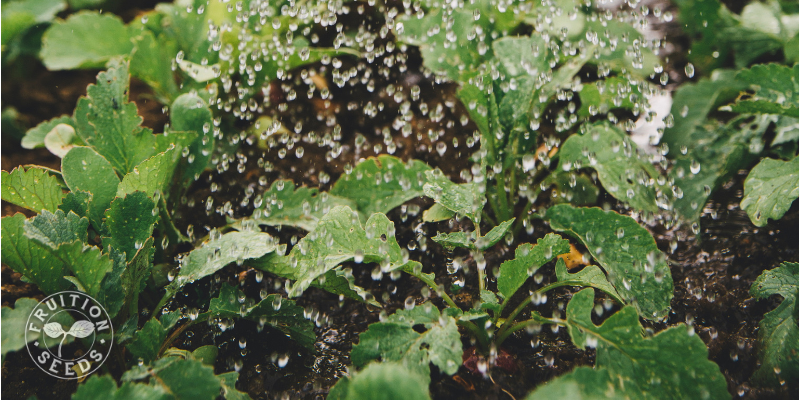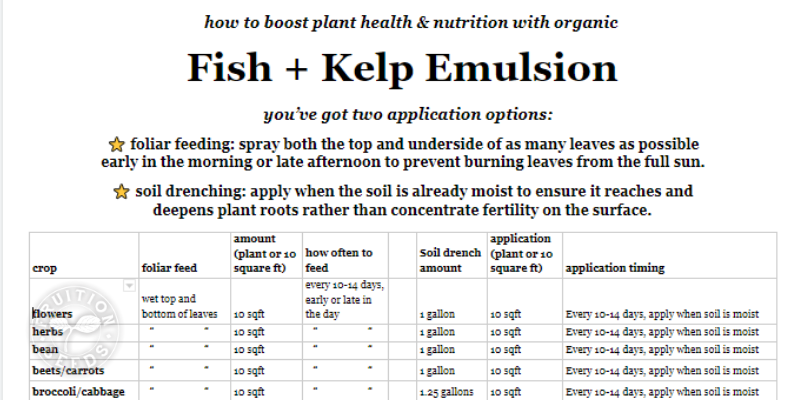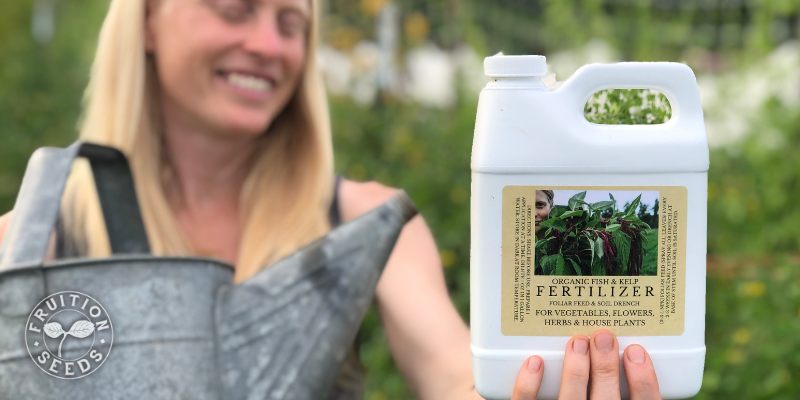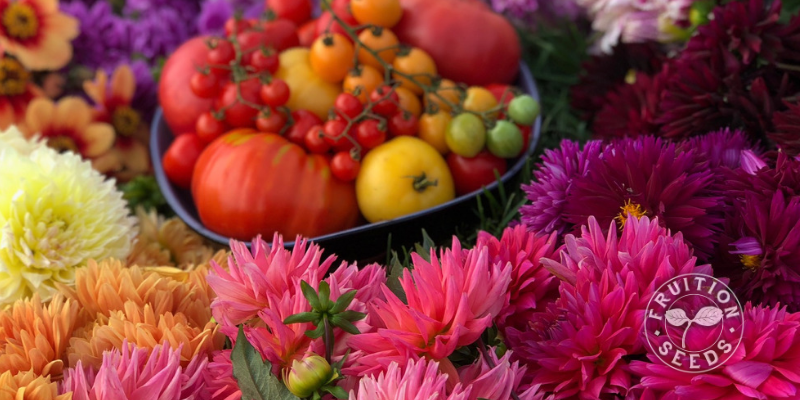Fertility is the foundation of soil health and plant health, which all very abstract, but it’s as simple as this: Abundance begets abundance, so don’t skimp and don’t be shy!
There are many ways to increase the fertility of your gardens, Friends.
Always, there is compost. Glorious, glorious compost. Soon I’ll share more about this, one of my favorite facts of life!
In the meantime, like two sides of a coin, our fish emulsion and granular fertilizer are easy to use and immensely effective across soil types. Of the many other approaches we use, cover cropping is a passion of ours and I look forward to sharing more with you about its art and science in the coming seasons.
Fruition’s Granular Fertilizer (a brief intro)
Our granular fertilizer is Matthew’s special blend of finely ground vegetables, animals and minerals, building soil as it feeds our crops with over one hundred micro- and macro-nutrients. We apply it in spring when we turn over our soil, allowing its slow-release nutrients to feed our soil and crops throughout the seasons. We share it here. There’s a lot more to share and soon I’ll share more! In the meantime, if you’re seeing yellow leaves and wondering how best to get nutrients to your plants:
Fish Emulsion to the Rescue!
Fish emulsion is a genius way to instantly offer an astonishing array of micro- and macro-nutrients to plants, boosting plant health as well as nutrient density. Ours is actually a fish plus kelp emulsion, offering a wider range of nutrients and more even, balanced growth than pure fish emulsion.

We begin feeding our one-month-old seedlings with fish emulsion and continue to feed them each week ’til frost to boost plant health and nutrient density.
How Often do I Apply Fish Emulsion?
Easy to use and incredibly versatile, we offer fish emulsion to feed everything in our gardens each week throughout the seasons, from seedlings in spring to tomatoes in fall and everything in between. You can feed less often — some is better than none — but we find well-fed plants are healthier plants, less susceptible to disease and more delicious, to boot. If you’re able to share fish emulsion with your garden two to four times per month, you’re really on top of your game and your garden will shine.
How is Fish Emulsion Best Applied?
You’ve got options! Since leaves up-take nutrients as well as roots (what?!! plants are AMAZING!!!), spraying leaves with dilute fish emulsion is a brilliant way to ‘foliar feed‘ your plants. This is especially helpful when you’re noticing nutrient deficiencies in your leaves, so the needed nutrients go right where they’re needed most. We have a dedicated bottle (and backpack sprayer, it’s true) to foliar feed our fish emulsion. Be sure to label your bottle! When foliar feeding we spray all the leaves, both above and below, focusing on the upper third of the new growth, who need it most.
If spraying isn’t a great option for you, simply pour your dilute fish emulsion directly on the roots, allowing it to soak in as a ‘root drench.’ As simplicity goes, you have arrived. Be sure to drench soil that is already moist, allowing roots to deepen more easily. How much liquid do you pour as a drench? We’ve made you a chart!
Download your free
✦ Fruition’s Fish Emulsion Fact Sheet ✦
and we’ll send it straight to your inbox!
*When you join us, check your inbox for your welcome & access info! Stay tuned for our weekly organic gardening tips & inspiration, as well*
Here’s a sneak peek:

When is Fish Emulsion Best Applied?
Whether you’re foliar feeding or root drenching, head to the garden before the sun gets high and hot in early morning. Late afternoon is second best. This timing minimizes leaf humidity while ensuring the sun won’t evaporate water too quickly or sunburn leaves through the drops.
What is the Proper Dilution of Fish Emulsion?
Dilute one ounce of fish emulsion into one gallon of water. And trust me, this is pretty non-negotiable! Less than this, you’re really not feeding your plants much, especially considering the effort. More than this, you’re inviting raccoons and skunk to come investigate. I notoriously measure very little, in the kitchen or in my garden, preferring to go by feel and play life by ear…but I do measure our fish emulsion.
What is Fish Emulsion?
Fish emulsion is a brilliant gift for every garden. It’s a dark brown, highly concentrated liquid, the by-product (‘by-catch’) of the fishing industry, fresh from the shores of New England. Bones, entrails and scales — basically anything not commercially viable — gets tossed back into the ocean, often creating toxicity from its sheer magnitude. Fish emulsion geniusly takes this by-catch, churns it into a liquid and allows rich oceanic minerals to return to terrestrial ecosystems once more.
Fish emulsion’s nutrients are the perfect size for plants to take-up into their leaves and roots instantly. We prefer to use fish plus kelp emulsion, promoting healthy growth across the vegetative/rooting/fruiting spectrum compared to simply fish emulsion. The N-P-K (nitrogen, phosphorus, potassium) ratio of our emulsion is 3-3-1.

A Note on Garlic, Shallots, Fish Emulsion & Dormancy
We feed fish emulsion to every crop each week on our farm, except for the crops that go into dormancy.
Garlic, shallots and onions need to dry down and go ‘dormant’ to cure well, If they’re offered abundant nutrients as they’re going dormant, they tend to grow quickly at the end but the new growth limits their capacity to dry down, cure and store long-term. For these crops, we stop feeding fish emulsion about four weeks prior to harvest. Here in Zone 5, we stop feeding our garlic and shallots about the third week in June, when hard-neck garlic begins to send up scapes. Onions tend to turn toward dormancy a few weeks after garlic, about mid-July.
Have fun experimenting, Friends! There are few forms of instant gratification as satisfying as sharing such abundance with your garden. Your plants will know the difference. You won’t help but notice
Sow Seeds & Sing Songs,

and the Many Beings of Fruition


Hi! Thanks for all your amazing resources, I love watching your videos 🙂 I’m also a huge fan of fish emulsion but I usually only use it while I start my seeds, transplant or if I notice deficiencies. I’d like to start using it on a more regular basis but I’m wondering how it affects the edible-ness of my plants? I grow medicinal plants and don’t typically wash them before consumption or transformation as I want to avoid high water content. Is there a time period to wait after doing a fish/kelp emulsion foliar spray or is it absorbed very quickly? Thanks so much!
usually a week out there is time for it to dissipate. you’ll have to experiment in small sprays and small bits to find how it works in your garden
I have started feeding my Howden pumpkin plants with one ounce of Alaska 5-1-1 liquid fish fertilizer once a week. How often should I feed them with this? They just sprouted a little more than a week ago. A couple of the seedlings already have their second true leaves on them, and they are really green. After putting Miracle Grow garden soil and good topsoil down, I mixed it all in with a 2-cycle gas powered tiller. It was really thick after adding all of this in the native soil and my tiller got stuck in certain places. As I was tilling, I could see that the composted cow manure that was added to the soil last year was being mixed in once again in certain places. I’m guessing the composted cow manure is still good. Since we can’t plant pumpkins in a different spot due to space and shady patches in the yard from our neighbor’s giant oak trees, we plant ours in the same sunny spot every year. We till and keep adding all of this stuff back into the ground each spring because pumpkins take a lot of nutrients out of it. And every year my pumpkins do quite well! After the season is over, we pick up all the dead vines and leaves and throw them in the trash can. Can I use Alaska liquid fish fertilizer on my Howden pumpkin plants throughout the growing season? Some say yes and others say only during the early stages of the plant’s growth. The nitrogen for this brand of fish fertilizer is nowhere near as high as Miracle Grow liquid fertilizer which is at 24%. And even though it’s only 1 % for each, this brand still has the phosphorus and potassium my pumpkin plants need plus other natural trace elements. Thank you for your help!
Hi Conner, thanks for asking. We start foliar feeding once pumpkins (and other fruiting plants) have 2 to 3 sets of true leaves and don’t stop until about one month before frost. The only time we recommend stopping fish & other fertility is 1 month before garlic is harvested, when scapes rise. We also recommend doing a soil test to decide how to amend the soil.